Tired of doing the same old cable rows day in and day out? It’s time to switch things up with the high cable row.
The high cable row is an upper-body exercise that primarily targets the upper and middle back muscles, including the latissimus dorsi, rhomboids, trapezius, and rear deltoids.
To do that, you must set a high pulley and pull the cable towards your upper chest in horizontal abduction.
This exercise can be performed in various ways to target back muscles from different angles, like using different grip positions and attachments.
- Wide D Handle Row Bar
- Straight bar
- Rope
- D Handle
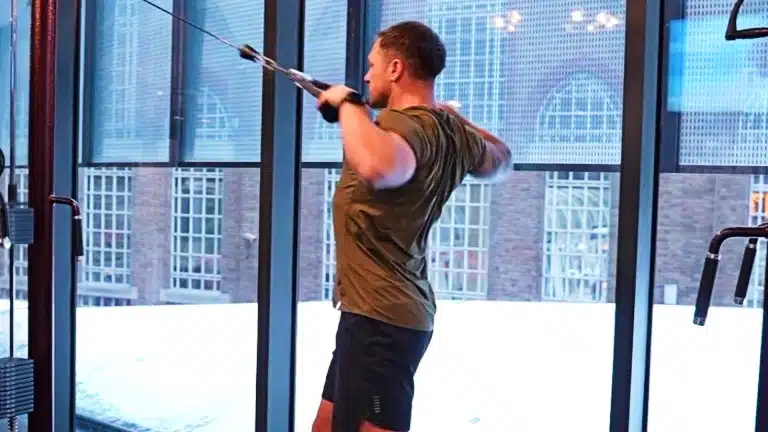
- High Cable Row Muscles Worked
- How To Do High Cable Row
- Pro-Tips and Form
- Variations And Modifications to Change Intensity
- 1. Kneeling Cable High Row
- 2. One Arm Cable High Row
- 3. Single Arm Kneeling Cable High Row
- FAQs
- High Cable Row vs face pull
- High cable row vs. lat pulldown
- Is the high cable row suitable for beginners?
- Can the high cable row be performed at home?
High Cable Row Muscles Worked
The cable high row is a compound exercise, which means it works many muscles simultaneously.
- The main muscles working during high rows are the rhomboids, scapula, rear deltoid, and trapezius.
- The secondary muscles worked during the rows were the biceps, brachialis, Brachioradialis, Core muscles, Latissimus dorsi, and Infraspinatus.
- Antagonist muscles worked: Chest, triceps, front deltoid.
- The muscle groups in the legs as either accessory dynamic movement stabilizers or as simple static support stabilizers.
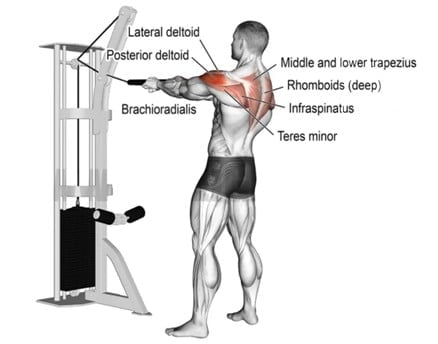
How To Do High Cable Row
- Attach a double-grip rope to a cable pulley about mid-chest level.
- Stand with your feet hip-width apart, your hips straight, your back tall, and your knees slightly bent.
- Grasp one end of the rope in each hand and step backward until the rope is pulled taut and your arms and shoulders are stretched.
- Keep your elbows out to the sides, and exhale as you pull the rope towards your shoulders until your elbows travel past your back, then pause for 2-3 seconds.
- Slowly straighten the arms to return the weight to the starting position.

Pro-Tips and Form
- Use a weight that you can handle comfortably and with good form. Using too much weight can cause you to lose form.
- Retract your shoulder blades to keep your rear delts engaged during the exercise.
- Keep your back straight while you do the exercise. Hunching your back can lead to a strain on your lower back.
- It is essential to maintain the correct posture while working out.
- Even though the exercise is called a high cable row, it’s important to avoid pulling the weight too high. Over-pulling the weight can cause shoulder impingement and other shoulder injuries.
- To fully activate your muscles, you should perform each rep slowly. It is best to avoid rapid and jerky movements.
- It is usually performed for at least 8–12 sets of moderate to high reps as part of an upper-body or shoulder-focused workout.
Variations And Modifications to Change Intensity
You can modify your high cable rows to match your fitness level.
If you are new to performing a high row, you may want to apply a few modifications to make the exercise easier.
- Start with lightweight and low reps.
- Increase the weight and reps once you can do the exercise perfectly.
When you’ve mastered form and can complete the exercise, it’s time to challenge yourself with variations.
- You can pull the cable with one arm at a time or with one arm along the side of your body.
- At the end of the pulling phase, pause for 3 to 5 seconds to challenge your muscles.
1. Kneeling Cable High Row
The kneeling position can help take some pressure off your lower back compared to standing high cable rows.
In addition, it is one of the most effective corrective exercises that help compensate for poor posture and shoulder dysfunction.

How To Do
- Set the cable up at a high point with the rope attachments
- Grab the rope with both hands using an overhand grip, then take a step back and get onto your knees.
- Starting with your arms stretched out and away, pull back through your elbows until your hands are just in front of your shoulders.
- Focus on the mind-muscle connection to pull down by using your back muscles.
- Slowly return to the starting position.
2. One Arm Cable High Row
We all have slight imbalances between our right and left sides. One-arm cable rows allow us to focus on each arm individually. This allows us to identify and address any weaknesses on one side compared to the other.
Besides being a great cable back exercise, this movement also works your hips, glutes and other lower body muscles.
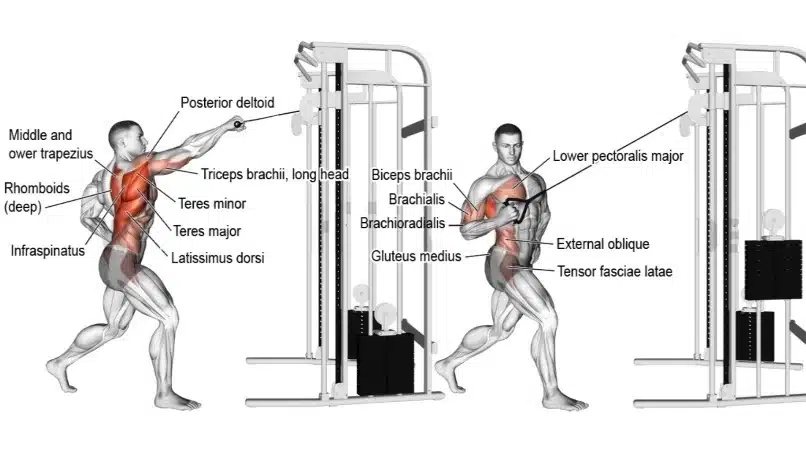
How To Do
- Attach a single grip handle to an elbow-high cable pulley.
- Step back and get into a staggered stance, knees slightly bent. Your arm should be out straight.
- Place your inactive hand on your other hip for added stability.
- Keep your elbow close to your body, pull back towards your waist, and rotate your waist in the same direction.
- Pause briefly at the movement’s top, then slowly return to the starting position.
3. Single Arm Kneeling Cable High Row
Kneeling exercises train your body to gain stability in areas where most people have problems, like the core and hips.
It is a great exercise for strengthening your back muscles, improving your posture, and engaging your core muscles.
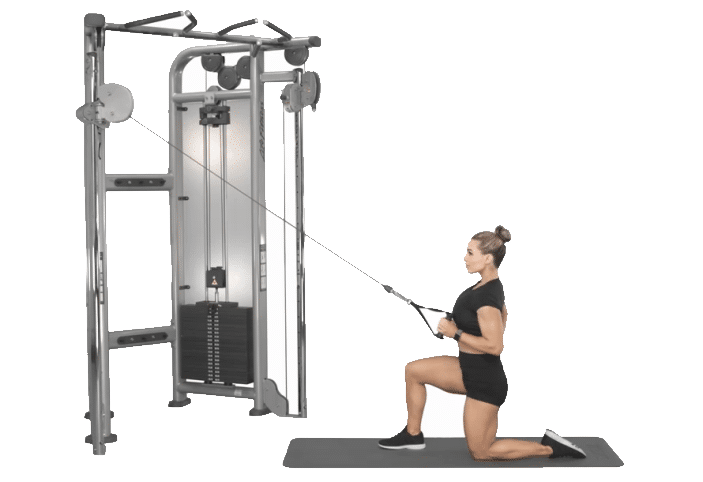
How To Do
- Attach a cable to a medium or high pulley.
- Get down on your right knee and face the cable about 3 feet away.
- Grab the handle with your right hand, palm facing in, and let your arm hang forward.
- Pull it towards your waist, keeping your elbow close to your body.
- Squeeze your shoulder blades together and hold for a second at the end of the movement.
- Slowly lower the cable back to the starting position and repeat for the desired reps.
- Switch to the other arm and repeat the exercise.
FAQs
High Cable Row vs face pull
- The high cable row involves pulling the cable towards the upper chest, while the face pull involves pulling the cable towards the face with the elbows pointed out to the sides.
- Both exercises target the upper back muscles, but the high row primarily targets the rhomboids, trapezius, and rear deltoids, while the face pull emphasizes the rear deltoids and upper back muscles such as the rotator cuff and lower trapezius.
High cable row vs. lat pulldown
- During the high cable row, the cable pulls towards the upper chest while standing upright, while during the lat pulldown, the bar or handles are pulled towards the chest while seated.
- The high cable row also focuses primarily on the rhomboids, trapezius, and rear deltoids, while the lat pulldown focuses primarily on the lats.
- The lat pulldown is often performed with heavier weights than the high row.
- The high cable row requires more core activation to maintain a stable posture, while the lat pulldown targets the upper back muscles.
Is the high cable row suitable for beginners?
Yes, the high cable row is suitable for beginners. They can start with a lighter weight and focus on mastering proper form.
Can the high cable row be performed at home?
Yes, you can do the high cable row at home if you have resistance bands.
Resistance bands can be anchored to a door frame or other sturdy object, and the movement can be performed like with a cable machine.
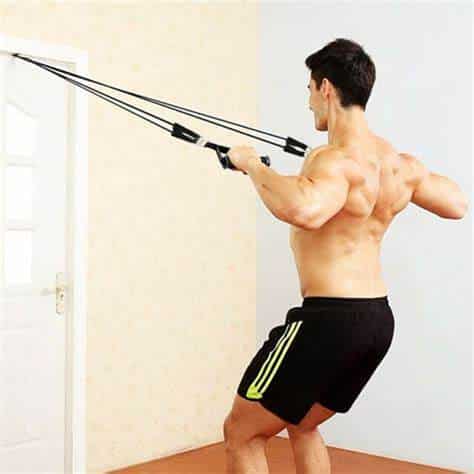

Manish brings over 10 years of hands-on experience in weight lifting and fat loss to fitness coaching. He specializes in gym-based training and has a lot of knowledge about exercise, lifting technique, biomechanics, and more.
Through “Fit Life Regime,” he generously shares the insights he’s gained over a decade in the field. His goal is to equip others with the knowledge to start their own fitness journey.
